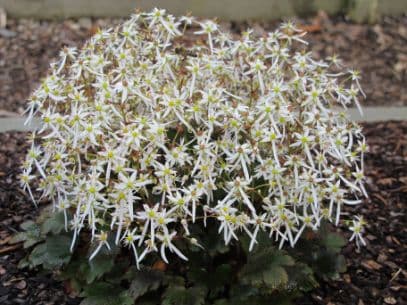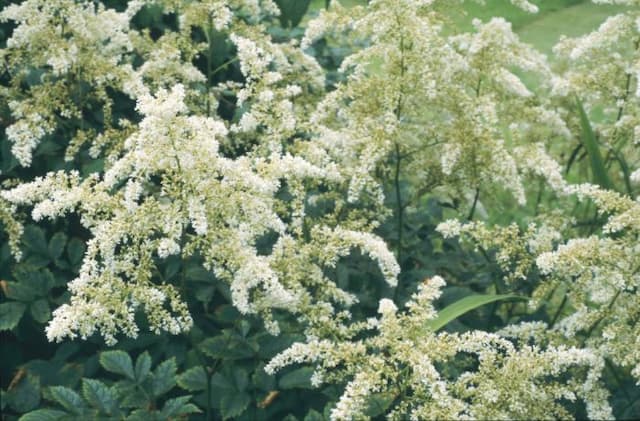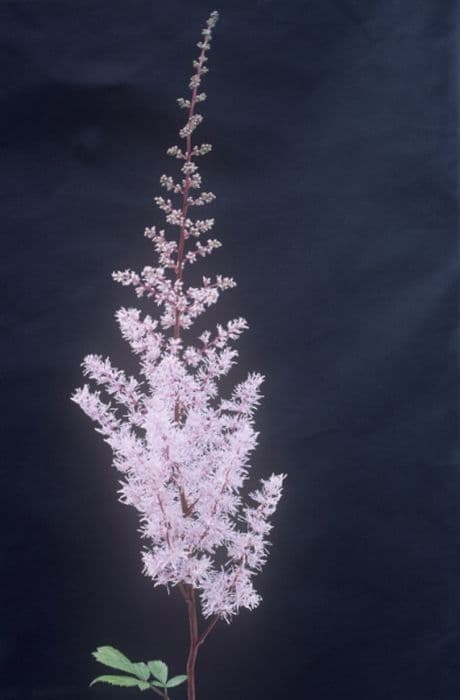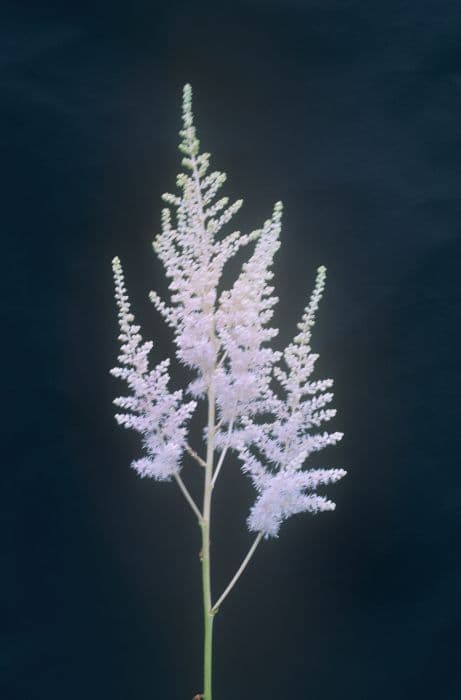Strawberry Begonia Saxifraga 'Rokujo' (fortunei) (5)

ABOUT
The Saxifraga 'Rokujo', also commonly known as mossy saxifrage or rockfoil, is a perennial plant that features a dense, cushion-like mat of small, bright green leaves. These leaves are typically rounded with a slightly lobed or toothed edge, giving them a delicate, fine-textured appearance. The foliage often forms a compact, mossy mound, which serves as a lush backdrop for the plant’s charming flowers. The flowers of the Saxifraga 'Rokujo' emerge on slender, wiry stems that rise above the foliage. These blossoms are quite striking, typically displaying a soft pink or sometimes white hue. Each flower sports five rounded petals that radiate out from a yellow-centered base, creating a star-like form. These blooms tend to cluster at the top of the stems, giving the impression of a frothy, airy display that adds a touch of whimsy to the plant's overall look. The plant is noted for its alpine or rock garden suitability, where it often nestles itself into crevices or spills over rocky ledges. Its spreading, mat-forming habit makes the Saxifraga 'Rokujo' an excellent groundcover option or addition to any garden looking for a tapestry of vibrant green foliage and delicate floral accents.
About this plant
 Names
NamesFamily
Saxifragaceae
Synonyms
Rokujo Saxifrage, Fortune's Saxifrage, Mossy Saxifrage
Common names
Saxifraga fortunei.
 Toxicity
ToxicityTo humans
The Saxifrage is generally considered non-toxic to humans. There are no well-documented cases of poisoning from ingesting Saxifrage, and it is not typically associated with adverse effects. Consequently, if any part of the Saxifrage plant is ingested, it is not expected to cause toxicity or poisoning symptoms in humans.
To pets
The Saxifrage is also generally recognized as non-toxic to pets. It does not contain any known toxic compounds that would pose a risk to animals if ingested. Therefore, ingestion of parts of the Saxifrage plant by pets is not expected to result in toxicity or lead to poisoning symptoms.
 Characteristics
CharacteristicsLife cycle
Perennials
Foliage type
Evergreen
Color of leaves
Green
Flower color
White
Height
6 inches (15 cm)
Spread
6 inches (15 cm)
Plant type
Herb
Hardiness zones
6
Native area
Japan
Benefits
 General Benefits
General Benefits- Ornamental Appeal: Saxifraga 'Rokujo' adds visual interest to gardens with its attractive foliage and delicate flowers.
- Ground Cover: This plant spreads effectively, covering bare spots and suppressing weed growth.
- Rock Gardens: Saxifraga 'Rokujo' is an ideal choice for rock gardens due to its ability to thrive in rocky, well-drained conditions.
- Low Maintenance: Once established, it requires minimal care, making it a suitable option for gardeners of all levels.
- Cold Tolerant: It can survive in colder climates, making it a versatile addition to various garden zones.
- Attracts Pollinators: The blooms of Saxifraga 'Rokujo' attract bees and other pollinators, supporting biodiversity.
- Seasonal Interest: With its changing foliage and flowering period, it adds seasonal interest to the garden.
 Medical Properties
Medical PropertiesThis plant is not used for medical purposes.
 Air-purifying Qualities
Air-purifying QualitiesThis plant is not specifically known for air purifying qualities.
 Other Uses
Other Uses- Educational Tool: Saxifraga 'Rokujo' can be used in botany classes to teach about alpine plant adaptations, due to its natural habitat in rocky mountainous areas.
- Photography Subject: With its delicate flowers and interesting foliage, Saxifraga 'Rokujo' serves as an excellent subject for macro and nature photography enthusiasts.
- Biological Indicator: This plant can be studied as an indicator of climate change impact, as alterations in bloom times may reflect changes in temperature patterns.
- Art Inspirations: The intricate pattern of Saxifraga 'Rokujo''s leaves and blossoms can be depicted in botanical drawings, paintings, and other art forms.
- Erosion Control: Planted in rocky areas, the Saxifraga 'Rokujo' can help stabilize soil and prevent erosion due to its mat-forming growth habit.
- Green Roof Planting: Its tolerance for poor soil and its low-growing nature make Saxifraga 'Rokujo' suitable for use in green roof installations.
- Cold Climate Gardens: Saxifraga 'Rokujo' is suitable for gardens in cold climates as it can survive low temperatures and enhance the garden's aesthetic during the bleak winter months.
- Bonsai Companion: Can be used as a complementary plant at the base of bonsai trees to add texture and color contrast in miniature landscapes.
- Study of Alpines: For gardeners and scientists studying alpine ecosystems, Saxifraga 'Rokujo' provides insight into alpine plant survival and reproduction strategies.
- Dye Source: Very rarely, Saxifraga 'Rokujo' may be explored as a source of natural dyes for small-scale, artisanal fabric dyeing processes; though this is not a common use.
Interesting Facts
 Feng Shui
Feng ShuiThe Saxifrage is not used in Feng Shui practice.
 Zodiac Sign Compitability
Zodiac Sign CompitabilityThe Saxifrage is not used in astrology practice.
 Plant Symbolism
Plant Symbolism- Determination: The genus name Saxifraga comes from Latin words "saxum" (rock) and "frangere" (to break), suggesting the plant's ability to grow in rocky, challenging environments, symbolizing determination and tenacity.
- Endurance: Its capability to survive in harsh conditions makes it a symbol of endurance and long-lasting life.
- Adaptability: As it can adapt to grow in various terrains, including crevices of rocks, Saxifraga represents adaptability and versatility.
- Protection: Often growing in alpine habitats, Saxifraga can be seen as providing a natural shield, symbolizing protection and safeguarding.
- Beauty: With its delicate flowers, Saxifraga signifies the idea that beauty can flourish against adversity.
 Water
WaterThe Strawberry Begonia prefers consistently moist soil, but it is important not to overwater. Water the plant when the top inch of soil feels dry to the touch. An appropriate method is to water thoroughly, allowing excess water to drain, and never let the plant sit in water. On average, this might be once a week, but you may need to adjust your schedule according to the humidity and temperature of your home. The amount needed will vary, but generally, half a gallon every two weeks should be sufficient for a plant in an average-sized pot.
 Light
LightStrawberry Begonias thrive in bright, indirect light. A perfect spot for these plants would be in an east or north-facing window where they receive gentle morning light or in a room with sufficient ambient light but shielded from harsh afternoon sun. Direct sunlight should be avoided as it can scorch the leaves.
 Temperature
TemperatureStrawberry Begonias prefer a temperature range between 60 to 75 degrees Fahrenheit. They can tolerate minimum temperatures down to about 50 degrees Fahrenheit but should not be exposed to temperatures lower than that. Keep these plants away from drafts and drastic temperature changes to maintain their ideal living environment.
 Pruning
PruningPruning Strawberry Begonias is done mainly to maintain their shape and remove any dead or damaged leaves. It's best to prune in the spring as the plant enters its active growing phase. Trimming can be done as needed throughout the growing season to encourage fuller growth; simply pinch off leggy stems to promote bushier foliage.
 Cleaning
CleaningAs needed
 Soil
SoilThe Saxifraga fortunei ‘Rokujo’, commonly known as Fortune’s Saxifrage, prefers a moist, well-draining soil mix with high organic matter. A mixture of peat, perlite, and fine bark works well. Aim for a slightly acidic to neutral pH of around 5.5 to 7.0 for optimal growth.
 Repotting
RepottingFortune’s Saxifrage should typically be repotted every 2-3 years to refresh the soil and allow room for growth. The best time to repot is in the spring, just as the plant is beginning to enter a new growth cycle.
 Humidity & Misting
Humidity & MistingFortune’s Saxifrage thrives best in moderate to high humidity conditions, ideally around 60-80%. Maintaining good humidity will support healthier foliage and growth but avoid overly wet conditions which can lead to rot.
 Suitable locations
Suitable locationsIndoor
Provide indirect light, cool temperatures, and moist soil for indoor Fortune’s Saxifrage.
Outdoor
Plant in partial shade, protect from hot sun, and keep soil consistently moist.
Hardiness zone
Fortune’s Saxifrage is suitable for hardiness zones 6-9 USDA.
 Life cycle
Life cycleSaxifraga 'Rokujo', also known as Fortune Saxifrage, begins its life cycle from seed, which germinates in moist, well-draining soil, preferably in a cool, shady environment. The seedlings emerge and develop into rosettes of thick, fleshy leaves, indicating the vegetative growth stage. As the plant matures, it produces short, stout flower stalks topped with clusters of small, star-shaped flowers in shades of white, pink, or red. After pollination, typically by insects, the flowers produce capsules containing numerous tiny seeds, completing the reproductive phase. Once seeds are dispersed, either by wind or rain, Saxifraga 'Rokujo' enters a period of dormancy, particularly in colder climates, to survive unfavorable winter conditions. In spring, the cycle restarts as temperatures rise and growing conditions improve, allowing for the next generation of seedlings to begin their growth.
 Propogation
PropogationPropogation time
Spring-Early Summer
The Saxifraga 'Rokujo', commonly known as Saxifrage, is a plant that is best propagated in the spring to early summer as this is when the plant is actively growing, and the conditions are favorable for root development. The most popular method of propagation for Saxifrage is by division. To propagate Saxifrage by division, carefully lift the parent plant from the soil and gently tease apart the clumps of rosettes or pull apart the offsets from the base. Each section should have a portion of the root system attached. Once separated, plant the divisions immediately into moist, well-draining soil at the same depth they were originally growing. The new plants should be watered well and kept in a shaded area until they are established, which may take several weeks, after which they can gradually be introduced to more sunlight.









